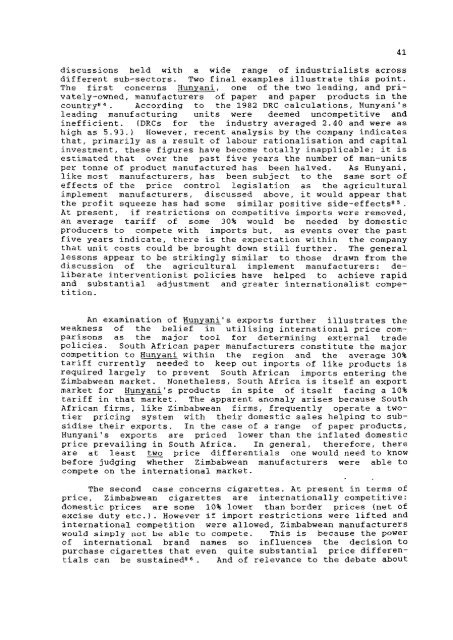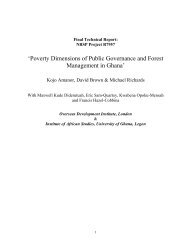Zimbabwe - Overseas Development Institute
Zimbabwe - Overseas Development Institute
Zimbabwe - Overseas Development Institute
Create successful ePaper yourself
Turn your PDF publications into a flip-book with our unique Google optimized e-Paper software.
discussions held with a wide range of i n d u s t r i a l i s t s across<br />
d i f f e r e n t sub-sectors. Two f i n a l examples i l l u s t r a t e t h i s point.<br />
The f i r s t concerns Hunyani, one of the two leading, and p r i <br />
vately-owned, manufacturers of paper and paper products i n the<br />
country'". According to the 1982 DRC c a l c u l a t i o n s , Hunyani's<br />
leading manufacturing u n i t s were deemed uncompetitive and<br />
i n e f f i c i e n t . (DRCs for the industry averaged 2.40 and were as<br />
high as 5.93.) However, recent a n a l y s i s by the company i n d i c a t e s<br />
that, p r i m a r i l y as a r e s u l t of labour r a t i o n a l i s a t i o n and c a p i t a l<br />
investment, these f i g u r e s have become t o t a l l y i n a p p l i c a b l e ; i t i s<br />
estimated that over the past f i v e years the number of man-units<br />
per tonne of product manufactured has been halved. As Hunyani,<br />
l i k e most manufacturers, has been subject to the same sort of<br />
e f f e c t s of the p r i c e c o n t r o l l e g i s l a t i o n as the a g r i c u l t u r a l<br />
implement manufacturers, discussed above, i t would appear that<br />
the p r o f i t squeeze has had some s i m i l a r p o s i t i v e side-effects^» .<br />
At present, i f r e s t r i c t i o n s on competitive imports were removed,<br />
an average t a r i f f of some 30% would be needed by domestic<br />
producers to compete with imports but, as events over the past<br />
f i v e years i n d i c a t e , there i s the expectation w i t h i n the company<br />
that u n i t costs could be brought down s t i l l f u r t h e r . The general<br />
lessons appear to be s t r i k i n g l y s i m i l a r to those drawn from the<br />
d i s c u s s i o n of the a g r i c u l t u r a l implement manufacturers: del<br />
i b e r a t e i n t e r v e n t i o n i s t p o l i c i e s have helped to achieve r a p i d<br />
and s u b s t a n t i a l adjustment and greater i n t e r n a t i o n a l i s t compet<br />
i t i o n .<br />
An examination of Hunyani's exports f u r t h e r i l l u s t r a t e s the<br />
weakness of the b e l i e f i n u t i l i s i n g i n t e r n a t i o n a l p r i c e comparisons<br />
as the major t o o l f o r determining e x t e r n a l trade<br />
p o l i c i e s . South A f r i c a n paper manufacturers c o n s t i t u t e the major<br />
competition to Hunyani w i t h i n the region and the average 30%<br />
t a r i f f c u r r e n t l y needed to keep out imports of l i k e products i s<br />
required l a r g e l y to prevent South A f r i c a n imports entering the<br />
<strong>Zimbabwe</strong>an market. Nonetheless, South A f r i c a i s i t s e l f an export<br />
market f o r Hunyani's products i n s p i t e of i t s e l f f a c i n g a 10%<br />
t a r i f f i n that market. The apparent anomaly a r i s e s because South<br />
A f r i c a n firms, l i k e <strong>Zimbabwe</strong>an firms, f r e q u e n t l y operate a twot<br />
i e r p r i c i n g system with t h e i r domestic sales helping to subs<br />
i d i s e t h e i r exports. In the case of a range of paper products,<br />
Hunyani's exports are p r i c e d lower than the i n f l a t e d domestic<br />
p r i c e p r e v a i l i n g i n South A f r i c a . In general, therefore, there<br />
are at l e a s t two p r i c e d i f f e r e n t i a l s one would need to know<br />
before judging whether <strong>Zimbabwe</strong>an manufacturers were able to<br />
compete on the i n t e r n a t i o n a l market.<br />
The second case concerns c i g a r e t t e s . At present i n terms of<br />
p r i c e , <strong>Zimbabwe</strong>an c i g a r e t t e s are i n t e r n a t i o n a l l y competitive:<br />
domestic p r i c e s are some 10% lower than border p r i c e s (net of<br />
excise duty e t c . ) . However i f import r e s t r i c t i o n s were l i f t e d and<br />
i n t e r n a t i o n a l competition were allowed, <strong>Zimbabwe</strong>an manufacturers<br />
would simply not be able to compete. This i s because the power<br />
of i n t e r n a t i o n a l brand names so i n f l u e n c e s the d e c i s i o n to<br />
purchase c i g a r e t t e s that even quite s u b s t a n t i a l p r i c e d i f f e r e n <br />
t i a l s can be s u s t a i n e d ' A n d of relevance to the debate about
















